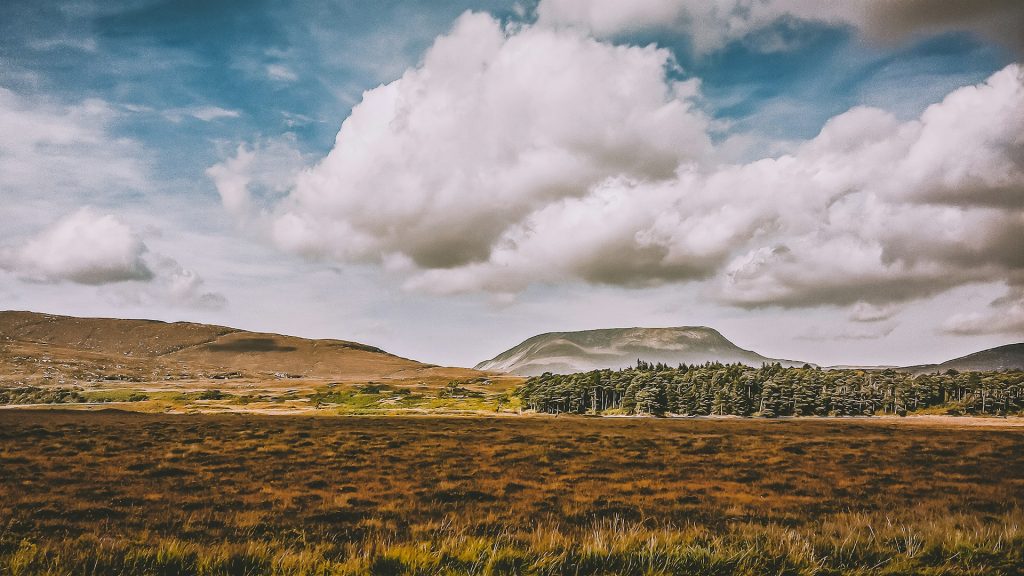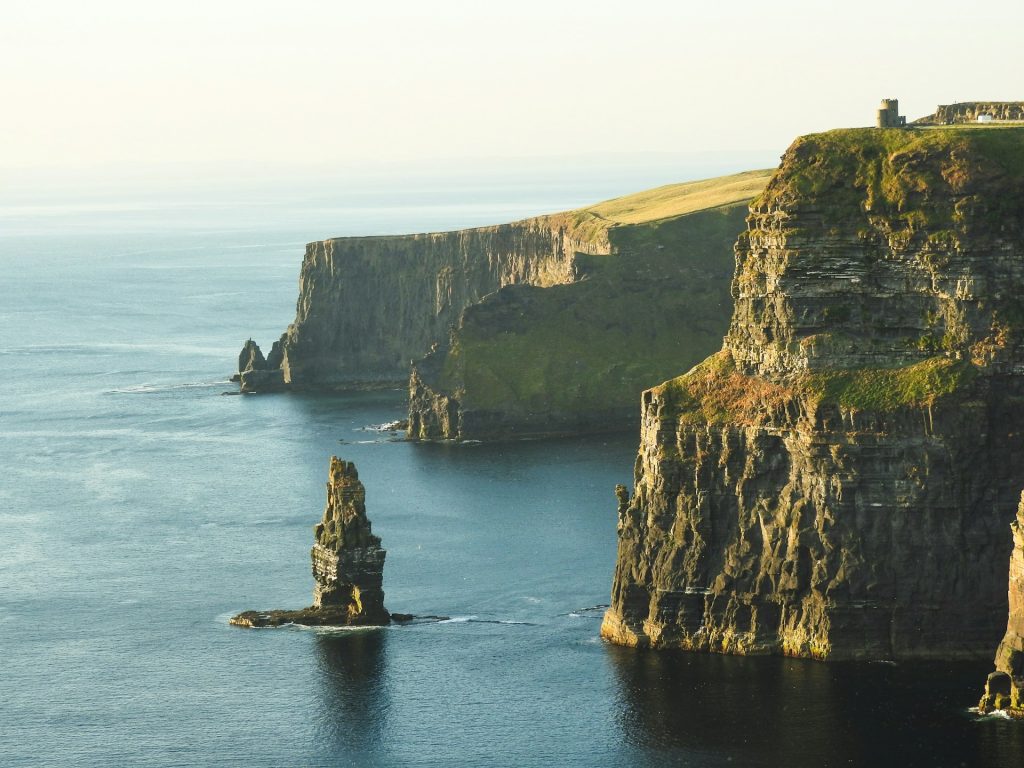Table of Contents
A one-week trip to Ireland, including visits to Dublin, western Ireland, and Northern Ireland, can cost anywhere from $1,500 to $5,000 per person. The total expense varies depending on the level of luxury and the specific Ireland itinerary, which may include costs for accommodation, food, transportation, and activities.
Travel in Ireland can include nights in Dublin experiencing traditional Irish stew and soda bread or venturing to explore historical sites like the Cliffs of Moher and the Ring of Kerry.
Accommodation prices range from hostels to castle hotels, and your daily budget could be from $100 for budget travelers to over $1,000 for luxury trips. Each choice, from dining out to guided tours, shapes the total trip cost.
Getting to Ireland and Getting Around

Travel in Dublin is just the beginning, with many options for exploring the Emerald Isle.
Flights and Airfare
Consider the national carrier for deals to Dublin or Shannon Airport when booking flights. Flight prices fluctuate, with the shoulder season offering milder weather and more affordable rates. Budget $500 to $1,000 for round-trip airfare from the United States, though prices may be higher during peak seasons or lower during sales. Ireland’s weather can be cold and wet, so pack accordingly to save on unexpected purchases.
Transportation in Ireland
Options abound for travel from Dublin to Belfast, Cork, or Galway, whether driving or using public transportation.
Rental Cars
Renting a car in Ireland provides the freedom to explore at your own pace. An economy car rental for those comfortable with driving in Ireland can cost $40 to $70 per day. Consider additional costs like insurance, fuel, and parking. Compare rental prices and book in advance for the best rates, especially during busy travel periods.
Public Transportation
Ireland’s public transportation network offers a convenient alternative for those who are uncomfortable driving. Buses and trains connect major cities like Dublin to Belfast, Cork, and Galway, with ticket prices varying based on distance and service type. Budget $20 to $40 for intercity journeys. A travel pass can offer savings for those visiting multiple destinations.
Guided Tours and Private Drivers
Guided tours and private drivers offer in-depth and stress-free experiences. Prices range from $50 to $200 per day, depending on the tour’s length and exclusivity. Private drivers provide a personalized experience at a higher cost, which is worth considering for convenience and expertise over budget.
Accommodation Options
Accommodation in Ireland ranges from bed and breakfasts to luxury castle hotels, with corresponding costs.
Private Villas
Consider a private villa in the Irish countryside for a truly memorable experience. Perfect for multigenerational families or couples traveling together, these top-rated homes offer spacious accommodations and premium amenities for a remarkable stay.
1. Wild Atlantic

Looking for an authentic Irish experience? This grand 1778 country house in County Clare was lovingly restored while retaining its traditional charm. You and 11 guests can relax by the fireplace or cook in the Victorian kitchen. Gather for a family dinner in the cozy dining room, warmed by a wood stove. Explore the nearby castle ruins and stroll through fields of daisies to Clarecastle.
2. Briar Stone

This charming 3-bedroom cottage, nestled between the Ring of Kerry and the Ring of Beara, offers stunning mountain views and fresh country air. Kenmare offers outdoor adventures, from hiking the Kerry Way and Carrauntoohil to sailing on Kenmare Bay. Explore the town’s historic lanes, pubs, and restaurants just steps from your door.
3. Rewrite the Stars

This private County Kerry coastal escape offers postcard-worthy sea and mountain views. It is nestled within three acres of lush lands between the Ring of Kerry and Wild Atlantic Way. The 4-bedroom hideaway feels remote, yet Kenmare town is just a 10-minute drive. Nearby Coss Strand beach and stargazing from the Dark Sky Reserve complete the experience.
Hotels and B&Bs
Hotels and B&Bs cater to all preferences, from cozy cottages to grand summer destinations.
Budget Options
Travelers can find budget-friendly accommodations starting at around $100 per night, including guesthouses or hostels, some with complimentary breakfast. They offer a cost-effective way to extend a stay in Ireland, though amenities may be basic. Consider travel insurance for added security during your travels.
Mid-Range Hotels
Mid-range hotels offer comfort and value, with prices ranging from $150 to $250 per night. Guests can expect amenities like on-site dining and en-suite bathrooms, enhancing their stay while exploring Ireland.
Luxury Hotels and Castles
Luxury and castle hotels offer a lavish stay combining comfort and history. Prices range from $250 to over $1,000 per night, based on location and amenities. Guests enjoy elegance and nobility, with four-poster beds and private dining overlooking sprawling estates. Many accommodations also feature fine dining, spas, and on-site golf courses.
Self-Catering Accommodations (Vacation Rentals, Cottages)
Travelers looking for a personalized and home-like environment can choose self-catering accommodations in Ireland, including vacation rentals and cottages. These options offer the freedom to explore Ireland at one’s own pace, especially during the popular summer travel months. Accommodation costs vary widely, but guests can expect to budget between $100 and $300 per night, depending on the location and amenities.
The charm of a bed and breakfast or the privacy of a cozy cottage adds to the allure of accommodation in Ireland. These self-catering options allow visitors to immerse themselves in local life, with kitchens to prepare meals and living spaces to relax after exploration. For longer stays, they offer a cost-effective alternative to traditional hotels while providing a taste of Irish hospitality.
Camping and Glamping Options
Camping in Ireland offers a budget-friendly way to connect with the outdoors. Prices range from $10 to $30 per night for a basic campsite. For a touch of luxury, glamping—glamorous camping—sites provide amenities like beds and electricity, starting at around $50 per night and going upwards of $150 for deluxe setups.
Food and Dining
Exploring food in Ireland is an adventure. Options range from hearty Irish breakfasts to contemporary cuisine. Dining out budgets will vary, but on average, travelers can expect to spend $15 to $30 for a traditional Irish breakfast or a meal at a pub or café.
Traditional Irish Cuisine and Pub Culture
The heart of Irish culinary tradition is in its pub culture, where a meal’s warmth matches the convivial atmosphere. Savoring Irish stew or biting into freshly baked soda bread in a cozy pub are experiences not to be missed. Prices for a pub meal range from $15 to $25, offering value and a genuine taste of Ireland’s hospitality. In these welcoming establishments, it’s about the food, laughter, stories, and memories.
Dining Out at Restaurants
Ireland’s restaurants offer a range of culinary delights, with dinner prices starting around $20 per person for budget-friendly options and increasing for finer dining.
Budget Cafes and Pubs
Travelers can save money by eating at cafes and pubs, where a satisfying meal can be enjoyed for $10 to $20.
Mid-Range Choices
Mid-range dining in Ireland offers a balance of quality and cost, with meals costing between $20 and $50 per person. While enjoying the flavors of Ireland, vacationers should consider a rental car to explore the culinary landscape spanning from city eateries to country taverns, enhancing their Ireland vacation.
Splurge-Worthy Experiences
Splurge-worthy dining experiences in Ireland can include tasting menus at Michelin-starred restaurants or private dining in a castle, with costs ranging from $75 to $250 per person. These meals often come with wine pairings and courses showcasing Irish produce, providing an unforgettable culinary journey for the discerning palate.
Grocery Costs for Self-Catering
Self-catering visitors will find grocery costs reasonable, with a week’s worth of basic items averaging between $75 and $100. During the shoulder season, when flight prices are lower, the savings can extend to food costs. However, travelers should be prepared for the cold and wet Irish weather, which can influence the cost and availability of produce. Choosing national carrier flights that land at Shannon Airport might offer more affordable options for those looking to manage their travel budget effectively.
Alcohol and Dining Out Costs
When dining out, alcohol can significantly add to the bill. A pint of Guinness costs around $5 to $7, while a glass of wine might range from $7 to $10. For those wishing to enjoy Ireland’s pub culture, budget an additional $15 to $30 per day for drinks, depending on personal consumption and the establishments visited.
Activities and Attractions

Planning your trip around Ireland’s activities and attractions is essential to maximize your travel experience. Aligning these experiences with your travel style can create a journey tailored to your interests, whether it’s marveling at the Book of Kells or tapping your feet to traditional Irish dancing.
Historical and Cultural Sites
The vibrant capital city of Dublin is full of historic sites such as Trinity College and the Guinness Storehouse. Kissing the Blarney Stone is just one of Ireland’s many historical and cultural sites that captivate travelers. Admission fees vary, but visitors can typically spend around $15 to $25 per person for entrance. This allows experiencing Ireland’s past without spending too much.
Natural Attractions
Ireland’s natural attractions, from its rugged coastlines to verdant landscapes, are often free to explore. Budget-conscious travelers can delight in the country’s scenic beauty with only minimal costs for parking or donations at certain sites, making it an affordable way to experience Ireland’s vistas. Popular destinations include:
- Cliffs of Moher: Breathtaking sea cliffs on the west coast.
- Ring of Kerry: A scenic drive through County Kerry with picturesque villages and coastal views.
- Giant’s Causeway: Unique hexagonal rock formations on the coast of Northern Ireland.
- Killarney National Park: A beautiful park with lakes, mountains, and historic Muckross House.
Outdoor Adventures
Ireland offers many outdoor activities, such as hiking, biking, and surfing the wild Atlantic waves. Costs vary, but budgeting $50 to $150 for guided excursions or equipment rentals is a safe estimate.
Festivals and Events
Ireland’s calendar is full of festivals and events celebrating its heritage and spirit. Each event offers a chance to revel in Ireland’s festive culture, from the energy of St. Patrick’s Day to the soulful tunes of the Galway International Arts Festival. These gatherings are not just for locals; travelers are welcome to join in.
Tours, Entrance Fees, and Activities
Attraction prices in Ireland vary, reflecting the diversity of activities. The Guinness Storehouse, a must-visit for stout enthusiasts, and Game of Thrones tours are popular paid attractions. Wild Wicklow tours offer a rugged escape, while Southern Ireland’s beauty can be appreciated through various entrance fees and activity costs for different budgets.
Travelers flock to these experiences:
- Dublin Castle: Discover the rich history of Dublin at Dublin Castle, a focal point of the city for centuries.
- Trinity College and the Book of Kells: Visit Trinity College in Dublin to see the ancient Book of Kells and explore the beautiful campus.
- Titanic Belfast: Learn about the tragic history of the Titanic at the Titanic Belfast Museum in Northern Ireland.
- Kylemore Abbey: Visit the picturesque Kylemore Abbey in Connemara, known for its stunning architecture and beautiful gardens.
Other Expenses
When planning a road trip across the Emerald Isle, it’s important to factor in incidental costs like parking, tolls, and fuel.
Travel Insurance
Prioritizing travel insurance for an Ireland vacation is wise. It covers medical emergencies, trip cancellations, and lost luggage, ensuring travelers stay protected.
Visas and Entry Requirements
Before an Ireland vacation, travelers should check visa and entry requirements, which vary by country and can impact travel planning and expenses.
Tipping Etiquette
Tipping isn’t obligatory in Ireland, but it’s customary to leave a 10-15% gratuity at restaurants for good service. Small tips for taxi drivers and hotel staff are also appreciated.
Souvenirs and Shopping
Shopping in Ireland offers unique finds, from the Claddagh ring symbolizing love and friendship to hand-knit sweaters. Budgeting for souvenirs ensures travelers can bring home Irish heritage.
Additional Costs for Families With Children
Families traveling to Ireland should budget for child-friendly attractions, family dining, and larger accommodations to ensure a comfortable trip.
Tips for Saving Money
Smart planning and flexibility can lead to significant savings on food, drink, accommodations, and attractions.
Traveling in the Low Season
Traveling during the low season offers significant savings. Accommodation rates drop, and attractions are less crowded, making it ideal to explore Ireland at a leisurely pace.
Staying in Residential Areas
Choosing accommodations in residential areas instead of tourist hotspots can drastically reduce lodging costs and provide a more authentic Irish living experience.
Using Public Transportation
Using public transportation instead of renting cars or taking taxis can help travelers save money and navigate Ireland like locals, with extensive networks covering urban and rural areas.
Buying Attraction Passes or Bundles
Attraction passes or bundles offer discounted rates to multiple attractions, helping visitors experience more while spending less.
Bargaining for Goods and Services
Bargaining isn’t common in Ireland, but asking for discounts on services or goods in markets or independent stores can yield savings.
Sample Itineraries

Budget Travel (10-14 days)
Budget-conscious travelers can explore Ireland’s landscapes and cities over 10-14 days with careful planning. Aim to spend approximately $50-$80 per day, covering hostel accommodations, groceries, and public transportation. Begin in Dublin, exploring the literary history and free attractions like the National Museum of Ireland.
Mid-Range Travel (7-10 days)
Budget $100-$150 daily for a mid-range trip to experience a comfortable yet authentic visit to Ireland. Stay in a mix of B&Bs and mid-range hotels and dine at moderately priced restaurants. Rent a car for flexibility to explore the Wild Atlantic Way.
Luxury Travel (5-7 days)
Budget $250-$500 per day for a luxury getaway with high-end accommodations, fine dining, and private tours. Start in Dublin with exclusive shops and restaurants, then a chauffeured ride to the Ring of Kerry.
Frequently Asked Questions
1. How much should I budget per day in Ireland?
While visiting Ireland, budgeting depends on the travel style. For a mid-range trip, plan for about $100-$150 per day. This should cover a comfortable stay, meals at a mid-range restaurant, and access to attractions. Transportation costs can be managed with public transport and occasional car rentals.
2. What is the best time to visit Ireland?
The best time to visit Ireland is during the shoulder seasons, from April to June and September to October. The weather is pleasant, and prices are moderate. These periods offer mild weather and fewer tourists, making it ideal for exploring the country’s landscapes and historical sites.
3. Do I need to rent a car in Ireland?
Renting a car in Ireland offers the freedom to explore remote areas and the Wild Atlantic Way at your own pace. If you’re comfortable driving on the left and navigating narrow roads, consider car rentals. Include rental insurance in your budget. Train tickets are also available for those preferring public transport.
Conclusion
Exploring Ireland offers diverse experiences for every traveler, from history and culture to natural beauty. Navigating the green hills by car or enjoying the hospitality of a local pub, the costs of your Irish getaway can vary. Balancing comfort, convenience, and authenticity will determine your trip’s cost.
When planning your dream vacation to Ireland, factor in costs for flights, lodging, food, and activities. Enjoy the country’s famous sites, warm people, and hidden gems off the beaten path. Careful planning, openness to unexpected delights, and treasured moments await you on the Emerald Isle.




